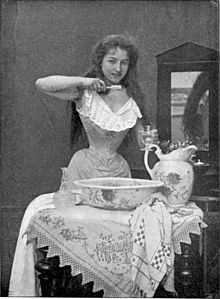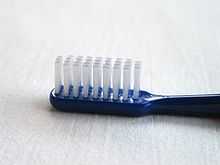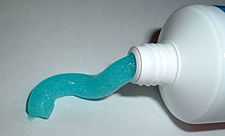Tooth brushing

Tooth brushing is a form of hygiene, in which a person cleans their teeth with a toothbrush.
Brushing teeth properly can prevent cavities, and periodontal, or gum disease, which causes at least one-third of adult tooth loss.[1] If teeth are not brushed correctly and frequently, it could lead to the calcification of saliva minerals, forming tartar. Tartar hardens (then referred to as 'calculus' if not removed every 24 hours. Poor dental health has been associated with heart disease and shortened life expectancy. [2][3][4]
Brushing one's teeth is an important part of dental care. As long ago as 3000 BC, the ancient Egyptians constructed crude toothbrushes from twigs and leaves to clean their teeth. Similarly, other cultures such as the Greeks, Romans, and Indians cleaned their teeth with twigs. Some would fray one end of the twig so that it could penetrate between the teeth more effectively.
Modern day toothbrushing as a regular habit became prevalent in Europe from the end of the 17th century. The first mass-produced toothbrush was developed in England in 1780. In the United States, although toothbrushes were available at the end of the 19th century, the practice did not become widespread until after the Second World War, when US soldiers continued the toothbrushing that had been required during their military service.[5]
Toothbrush

The toothbrush is an instrument used to clean teeth, consisting of a small brush on a handle. Toothpaste, often containing fluoride, is commonly added to a toothbrush to aid in cleaning. Toothbrushes are offered with varying textures of bristles, and come in many different forms and sizes. Most dentists recommend using a toothbrush labelled "Soft", since firmer bristled toothbrushes can damage tooth enamel and irritate gums as indicated by the American Dental Association. Toothbrushes are often made from synthetic fibers, although natural toothbrushes are also known in many parts of the world. Those with dentures may also brush their teeth with traditional tooth brushes, specially made denture brushes or denture cleaners.
Toothpaste

Toothpaste is a paste or gel dentifrice used to clean and improve the aesthetic appearance and health of teeth. It is almost always used in conjunction with a toothbrush. Toothpaste use can promote good oral hygiene: it can aid in the removal of dental plaque and food from the teeth, it can aid in the elimination and/or masking of halitosis when tonsil stones are not the cause, and it can deliver active ingredients such as fluoride to prevent tooth and gum (Gingiva) disease.
Tooth powder
Tooth powder (or 'toothpaste powder') is an alternative to toothpaste. It may be recommended for people with sensitive teeth. Tooth powder typically does not contain the chemical sodium lauryl sulphate which can be a skin irritant.[6] The function of sodium lauryl sulphate is to form suds when teeth are brushed. It is a common chemical in toothpaste. Those with dentures may also use denture cleaner which can also come in powder format.
See also
References
- ↑ Fridus van der Weijden; Dagmar Else Slot (Nov 2, 2012). "The effectiveness of toothbrushing". Dental Tribune.
- ↑ Systemic Diseases Caused by Oral Infection Clinical Microbiology Reviews, October 2000, p. 547-558, Vol. 13, No. 4
- ↑ Osteoporosis and Periodontal Disease Division of Periodontology, Department of Dentistry, Taipei Veterans General Hospital, School of Dentistry, National Yang-Ming University, Taipei, Taiwan, R.O.C.
- ↑ Periodontal infections and cardiovascular disease JADA, Vol. 137. October 2006
- ↑ Mary Bellis. "History of the Toothbrush and Toothpaste". About.com Money.
- ↑ "MATERIAL SAFETY DATA SHEET ON SODIUIM LAURYL SULFATE". healthy-communications.com.